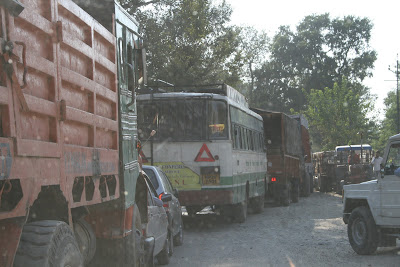The Greatest Generation...
Unfortunately when our team left Dharamsala for Amritsar, I got notice that my Grandfather had fallen gravely ill. Before leaving for India, I had promised him that I would do Ardas (pray) in Amritsar, the Sikh holy city. 
We were in Amritsar until the October 27th, and left for Delhi via train. I knew I needed to go home urgently. I arrived in California late October 28th, and went directly to the hospital where my Grandfather was. I spent that evening and the next day with him until he took his last breath on October 29th.
 A.S. Sandhu, 1913-2006
A.S. Sandhu, 1913-2006
He is the survivor of India's independence from the British, the bloody Partition of Punjab after the British relinquished control of India, and the tragic loss of all his children except his one living daughter. Bloodshed and disease were rampant during that time and medical care was poor, if not absent. He was a true survivor, eternally in chardi kala (high spirits). His dignity, wisdom, talent, and total dedication and integrity inspired awe and respect for him from all who came in contact with him. He lived his belief of purity of mind (ishnan), compassion for all human beings (daan), and unshakable love for God and his creation (naam). He exemplified dignity of labor by being a doer, a creator who was actively involved all his life.
Tom Brokaw wrote a book about the generation of American heroes who were in their prime during the Great Depression and World War II. This generation was linked not only by a common purpose, but also by common values--duty, honor, courage, service, love of family and country, and, above all, responsibility for oneself. In this book, Brokaw introduces people whose everyday lives reveal how a generation persevered through war, and were trained by it. It is said that generation was "the greatest generation any society has ever produced."
Along similar lines, I feel the same way about the Indian men and women who lived during World War II, the fight against British imperialism, the fight for India's independence, and the deadly Partition of Punjab. My grandparents are of this era. Despite losing everything including their home, land, priceless family tree and heirlooms, and the many family members along the way, they remained steadfast in their integrity, dignity, courage, love of family and country, and their responsibility as human beings.
It seems like the end of an era...a time and place that will never be the same again. My Grandfather has been the most influential and dearest person in my life. Coming to terms with his passing is so sad and make me wish for a time long past. My Grandfather's faith in God was deep and his gentleness, yet strength were admirable...He had qualities were exceptional, and I am confident he is someplace very lovely...We celebrated his incredible life and his beautiful legacy.
Sri Harimandar Sahib, where I prayed for my Grandfather
















































